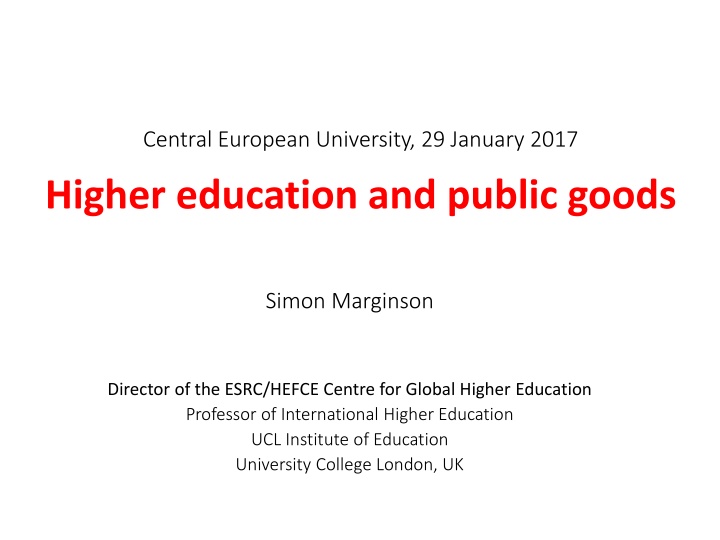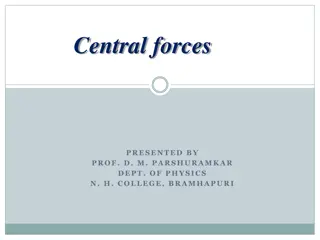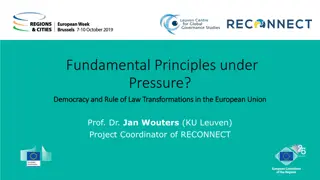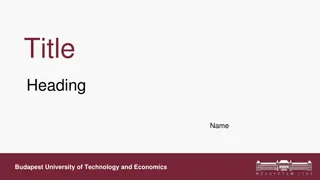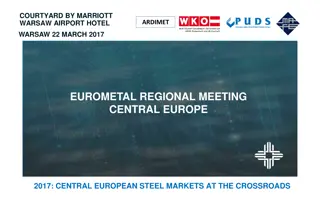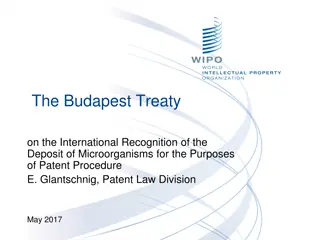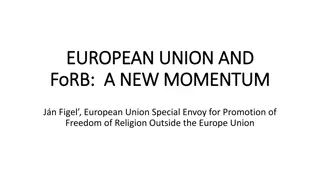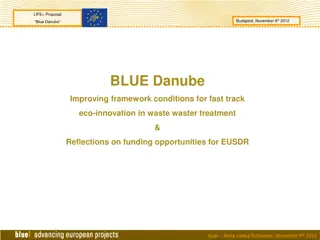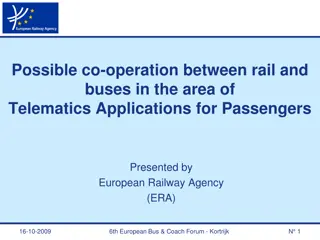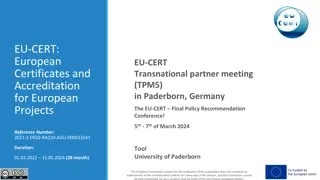The Role of Public Goods in Higher Education
This paper discusses the concept of public goods in higher education, exploring how they are defined, observed, and improved. It analyzes the distinctions between public and private goods based on economic and juridical-political factors, and examines the significance of public goods in advancing society and human rights. The article also delves into the economic definition of public and private goods, highlighting the importance of addressing non-market production and market production in education. Additionally, it presents estimates of private non-market benefits of college education, shedding light on the broader impact of higher education.
Download Presentation

Please find below an Image/Link to download the presentation.
The content on the website is provided AS IS for your information and personal use only. It may not be sold, licensed, or shared on other websites without obtaining consent from the author.If you encounter any issues during the download, it is possible that the publisher has removed the file from their server.
You are allowed to download the files provided on this website for personal or commercial use, subject to the condition that they are used lawfully. All files are the property of their respective owners.
The content on the website is provided AS IS for your information and personal use only. It may not be sold, licensed, or shared on other websites without obtaining consent from the author.
E N D
Presentation Transcript
Central European University, 29 January 2017 Higher education and public goods Simon Marginson Director of the ESRC/HEFCE Centre for Global Higher Education Professor of International Higher Education UCL Institute of Education University College London, UK
Three questions about public good 1. Is the public/private line a distinction between - non-market or market forms of education (economic distinction), - state or non-state controlled forms of education (juridical-political distinction)? 2. What are public goods in higher education? How are they defined, observed, measured and improved? 3. What if anything is normatively good about public goods in higher education?
This paper A theorisation of public/private in general, that combines the Paul Samuelson economic distinction (non-market vs market) with the juridical-political distinction (state vs non-state). See also Marginson, S. (2016). Private/public in higher education: A synthesis of economic and political approaches. Studies in Higher Education. DOI 10.1080/03075079.2016.1168797 Application of this framework to higher education and research Some public goods in higher education are common goods, advancing relational society and human rights The questions of national variation in approaches to national public/private goods in higher education, and global public goods in a nationally-bound world
Economic definition of public/private based on market vs. non-market production Samuelson (1954) Public goods are non-rivalrous and/or non excludable. They are under-produced or unproduced in economic markets. All other goods are private goods
Economic public goods: non-rivalrous and non-excludable Goods are non-rivalrous when consumed by any number of people without being depleted, e.g. knowledge of a mathematical theorem, sustains use value everywhere, globally, indefinitely, on the basis of free access Goods are non-excludable when benefits cannot be confined to individuals, e.g. clean air regulation, defence Private goods are neither non-rivalrous nor non- excludable. They can be produced, sold and bought as individualised commodities in economic markets. This public/private distinction is between non-market production and market production Research is primarily a public good. Teaching/student places can be either public or private; depends on policy
McMAHONS ESTIMATE Of PRIVATE NON MARKET BENEFITS OF COLLEGE EDUCATION (direct benefits, average college graduate, 4.5 years of education, 2007 US dollars) Own health benefits 16,800 Own longevity 2179 Spouse s health 1917 Child s health 4340 Child s education and cognitive development 7892 Management of fertility and lower family size 1551 Better consumption and saving patterns 3401 Total value of quantified private non-market benefits p.a. 38,080 Other positive non-market private effects (unquantified) related to job conditions and location amenities, better tastes, less obsolescence of skills due to better general education, greater well-being via enhanced income, etc. See McMahon 2009.
McMAHONS ESTIMATE Of DIRECT SOCIAL EXTERNALITIES OF COLLEGE EDUCATION (average college graduate, 4.5 years of education, 2007 US dollars) Democratization and political institutions 1830 Human rights and civic institutions 2865 Political stability 5813 Community life expectancy 2308 Reduced inequality (greater opportunity, less poverty, etc.) 3110 Less crime 5647 Reduced health costs and prison costs 544 Environment (cleaner air and water, less deforestation) 5609 Total social benefits 27,726 Other positive social benefits (unquantified here) related to higher tax receipts, social capital, the dissemination of the outcomes of R&D. See McMahon 2009.
McMAHONS ESTIMATE Of TOTAL BENEFITS OF COLLEGE EDUCATION (average college graduate, 4.5 years of education, 2007 US dollars) Net private earnings benefits p.a. 31,174 Non-market private benefits p.a. 38,080 Direct social benefits (direct externalities) p.a. 27,726 Total p.a. 96,980 Direct social externalities constitute 29 per cent of the total benefits of higher education. However, total externalities include the indirect social benefits. These are the contributions of externalities to the value generated in private earnings and private non-market benefits. Once this indirect element is included, McMahon estimates that externalities total 52 per cent of the average value of higher education.
The economic public/private distinction Non-market goods Teaching: Private learning in Internet, libraries, or in institutional HEIs,, low cost or free, high access, low value differentials Research: Self-made scholarship and inquiry, or In institutions, publicly funded, integral to researcher Teaching: Commercial market in tuition/degrees, or Government controlled quasi market in student places/degrees Research: Commercial research and consultancy, or State quasi-market, competition between HEIs, product formats Market- produced goods
Political definition of public and private state vs. non-state The line between public and private is to be drawn on the basis of the extent and scope of the consequences of acts which are so important as to need control, whether by inhibition or by promotion The public consists of all those who are affected by the indirect consequences of transactions Matters with consequences for others include market transactions, organisation of education systems, etc This public/private distinction is between state- controlled and non-state controlled production ~ John Dewey, The Public and its Problems, 1927, pp. 15-16
The political public/private distinction Teaching: High access, free places, low value differentials between HEIs and places, or Quasi market in student places/degrees, with competition, some fees but not full commercialisation Teaching: Private learning in Internet, libraries, or Commercial market in tuition/degrees State sector goods Non-state sector goods Research: Self-made scholarship and inquiry, or Commercial research and consultancy outside close state regulation Research: Publicly funded research programmes in HEIs in which peers drive knowledge with limited competition for funds, or State quasi-market, highly competitive, use of product formats in research
Putting the two definitions together The economic distinction is non-market vs market The political distinction is state vs non state Thus for Paul Samuelson higher education is public, unless it can be produced in a market outside the state. For John Dewey public or private is decided by states and/or democratic communities The economic and political definitions each have virtues, but also gaps, and each is ambiguous Putting them together creates four unambiguous categories (four political economies) that can be used to explain higher education and research
Public and private goods: four political economies of education Non-market goods Quadrant 2: SOCIAL DEMOCRACY Quadrant 1: CIVIL SOCIETY Teaching: Free places, low value differentials Teaching: Private learning in Internet, libraries Research: Publicly funded, integral to researcher Research: Self-made scholarship and inquiry State sector goods Non-state sector goods Quadrant 4: COMMERCIAL MARKET Quadrant 3: STATE QUASI-MARKET Teaching: Commercial market in tuition/degrees Teaching: Quasi market in student places/degrees Research: State quasi- market, product formats Research: Commercial research and consultancy Market- produced goods NOTE: State, institutions and individuals are active agents in all four quadrants
Common goods Not all public goods are necessarily progressive in distribution or in their social effects (e.g. national military offensives are a public good in both the economic and political senses, but do we like them?) Collective goods are a particular kind of political public good. These are relational goods that provide for such qualities as social solidarity, equity, human rights, democratic self-determination, and social and geographic mobility (freedom of movement) in populations The provision of higher education on the basis of equal social opportunity and maximum social mobility is one such common good
Published 19 December 2016, Melbourne University Publishing https://www.mup.com.au/items/199659
National variations in public goods United States Nordic Post-Confucian (East Asia and Singapore) Nation-state Limited liberal state, federal, separate from economy and civil order, constraints on state intervention. HEIs in civil society? Comprehensive Nordic welfare state, unitary, equated with society, fosters cooperative and egalitarian HEIs Comprehensive Sinic state, politics commands economy. Unitary. High status state (top graduates enter state service) Educational culture Meritocratic and competitive market. Highly stratified, but education seen as common road to wealth/status within advancing prosperity Egalitarian, free of charge, cooperative, universal, public. Low stratification of HEIs. State guaranteed medium for equal opportunity Education for filial duty and social status in stratified system. Confucian commitment to self-cultivation at home plus state belief in economic benefits. State and family role in higher education State frames hierarchical market and steps back. Middle class family increasingly invests private resources State supervises high quality egalitarian provision. Autonomy of HEIs. Family citizen right to free education State supervises, shapes and drives the sector. Managed autonomy. Family invests much energy, time, money
Global public goods Global public goods are goods that have a significant element of non-rivalry and/or non- excludability and made broadly available across populations on a global scale. They affect more than one group of countries, are broadly available within countries, and are inter-generational; that is, they meet needs in the present generation without jeopardizing future generations. ~ Inge Kaul, I. Grunberg and Marc Stern (Eds.), Global Public Goods: International cooperation in the 21st century, New York, Oxford University Press, 1999, pp. 2 3
Whose public goods? Are there generic public goods in higher education? Is there a generic/worldwide public good in higher education? Or is public good just in the eye of the beholder and incapable of generic form ? e.g. whose global public good Also, which tradition of state and public should we use Anglo-American, Nordic, German social market, Chinese, Latin American, etc? Or should we use a combined idea of state ? If there are generic goods, can we separate the generic goods from those subject to national variation? If so what factors shape national variations? Certain global public goods, and common goods pertaining to human rights, social solidarity and equality, might be among the generic public goods in higher education. A key problem at world level is that it needs a state to maximise distributional equity of public goods and there s no global state
Closing points 1. Both the state/non-state and the non-market/market distinction are relevant 2. Public goods in higher education are in danger of elite capture: the role of the state is key to this problem 3. Common goods (goods that sustain and augment sociability on the basis of equality and rights) have a special importance 4. The state s role in higher education and research is specific to national political and educational cultures 5. Global public goods in higher education need more explicit attention
